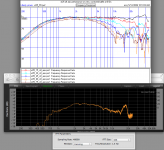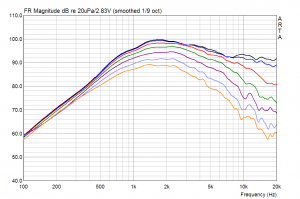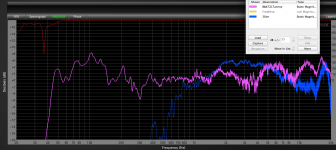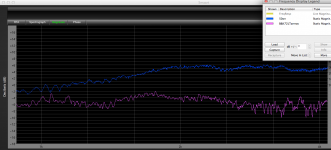Smooth frequency response, smooth polar response, accurate transient response, wide dynamic range all are important, but which is most important is a subjective choice we each make.Lynn, the low end of the XT25 gets a huge boost, about 10db in the 1-4 kHz range. Pretty useful. Further up, the response evens out. But as you mention, there are many dips and peaks, apart from the low end boost.
Apart from real measurements, I guess I was posing a more fundamental question about whether given the right matching between dome/ring radiator and waveguide, can it be superior to a CD/horn combo? Is the response of a traditional tweeter inherently smoother than that from a CD? If all we are craving is directivity, then it might be a worthwhile solution.
To be "superior" in audio is a subjective quality.
The Vifa XT25 appears to be smoother than most horn/compression drivers, an example of the XT25 and a BMS 4550 on a conical horn (frequency resolution of 1.5 Hz like you wanted) below.
Of course, as you mention, the XT25 in a waveguide does not have smooth response.
Even if the waveguide provides the XT25 10 dB of midband gain, it still is an order of magnitude lower than most compression driver/horns, it will take the full power of 50 watts to achieve the SPL that 5 watts would do with the compression driver.
The directivity of the XT25 narrows to about 90 degrees at 10 kHz, so a 90 degree waveguide will have no increase in sensitivity that high, comparing the BMS 4550 on the conical horn to the XT25 at 10kHz we would see (hear) more like a 15 dB drop in sensitivity (20 dB on the horn used in the comparison which is 115 dB one watt one meter midband).
Once you have messed with the smooth on axis response of the XT25 by putting it in a waveguide, it looses that metric of being "superior", and from a dynamic standpoint, it can't come close to a good compression driver.
Art
Attachments
Last edited:
Once you have messed with the smooth on axis response of the XT25 by putting it in a waveguide, it looses that metric of being "superior", and from a dynamic standpoint, it can't come close to a good compression driver.
Art
The shown response on the waveguide tracks the flat-baffle power response and looks quite smooth to me, with the exception of the one big peak. If you mean that the "lump" response isn't smooth, that's a problem with compression drivers too, they all exhibit that behavior on constant directivity horn/waveguides (but you already knew that). Is it just the HF peak that's bothering you? Certainly one would want to notch that.
For home levels, the need for the higher output and power handling of a compression driver are less key, I'm using a soft dome on a constant directivity horn and getting great results once the power response is accounted for, for my rear-firing section of my speakers.
An externally hosted image should be here but it was not working when we last tested it.
Unlike many contributors in this post, peaks don't bother me, I just equalize them outThe shown response on the waveguide tracks the flat-baffle power response and looks quite smooth to me, with the exception of the one big peak. If you mean that the "lump" response isn't smooth, that's a problem with compression drivers too, they all exhibit that behavior on constant directivity horn/waveguides (but you already knew that). Is it just the HF peak that's bothering you? Certainly one would want to notch that.
The upper graph in #8761 is a stock Vifa XT25 on a flat baffle measured at .5 meter that I found when Googling that driver.
The lower graph is a BMS 4550 compression driver on a Welter Systems Maltese horn on a 1 square meter flat baffle about 5 feet off the ground pointed skyward outside at two meters.
As far as I know, ra7 has not posted any graphs of his XT25 on a waveguide, but he wrote it "gets a huge boost, about 10db in the 1-4 kHz range".
Neither graph shows his observation, they were just presented to show relative smoothness between a compression driver/horn and the tweeter he uses, without a waveguide.
Art
I do have measurements, in Holm, that I can post later this evening.
I'm aware of the ultra flat response of the XT25 on a baffle. On the SEOS-12, there are peaks and dips, but these can be EQed. In a CD, there are many small squiggles that look flat when smoothing is applied. That is the difference I'm trying to understand.
I was recently re-reading Toole's book, especially Chapter 18. He says that smoothness of the response was found to have higher preference compared to flatness. Small resonances that are usually lost in smoothed or gated measurements are very audible.
I'm aware of the ultra flat response of the XT25 on a baffle. On the SEOS-12, there are peaks and dips, but these can be EQed. In a CD, there are many small squiggles that look flat when smoothing is applied. That is the difference I'm trying to understand.
I was recently re-reading Toole's book, especially Chapter 18. He says that smoothness of the response was found to have higher preference compared to flatness. Small resonances that are usually lost in smoothed or gated measurements are very audible.
The upper graph in #8761 is a stock Vifa XT25 on a flat baffle measured at .5 meter that I found when Googling that driver.
The lower graph is a BMS 4550 compression driver on a Welter Systems Maltese horn on a 1 square meter flat baffle about 5 feet off the ground pointed skyward outside at two meters.
Ah- I missed that- I thought the lower was the XT25 on a WG- thanks for the clarification.
Small resonances that are usually lost in smoothed or gated measurements are very audible.
Hello ra7
Yes but typically not in the tweeters bandwidth, the lower frequencies where you need longer gate times are where you see it the most. It's not all that hard to just look at the ungated measurement to see what's going on. Also depends on the Q and amplitude, higher Q generally being less audible than a lower Q resonances.
Rob
"Small", another relative term when it comes to resonances. I don't hear the .5 to 3 dB resonances in a "smooth" horn driver, but when they are large enough, like 6-12 dB, then I may detect the difference in an A/B test.I do have measurements, in Holm, that I can post later this evening.
I'm aware of the ultra flat response of the XT25 on a baffle. On the SEOS-12, there are peaks and dips, but these can be EQed. In a CD, there are many small squiggles that look flat when smoothing is applied. That is the difference I'm trying to understand.
I was recently re-reading Toole's book, especially Chapter 18. He says that smoothness of the response was found to have higher preference compared to flatness. Small resonances that are usually lost in smoothed or gated measurements are very audible.
The Vifa XT25 may be smoother than the Vifa dome tweeter in the Tannoy PBM 6.5 I use in my control room.
The same BMS 4550 from post 8761 and the PBM 6.5 are both shown below with no smoothing, 1.5 Hz resolution.
The horn/driver is "smoother" in the critical 1-6 kHz range, the dome tweeter smoother (but less flat) above 6 kHz.
At any rate, some of the drivers I tested were less smooth, all equalized relatively flat, you can listen to them and report back if you are in agreement with Toole.
My ears are not golden enough to tell them apart until driven in to distortion.
http://www.diyaudio.com/forums/multi-way/212240-high-frequency-compression-driver-evaluation.html
Recordings of six drivers using different diaphragm materials and size, phase plug designs, and magnet structures, all on the same horn are there.
Art
Attachments
Last edited:
Hello ra7
Yes but typically not in the tweeters bandwidth, the lower frequencies where you need longer gate times are where you see it the most. It's not all that hard to just look at the ungated measurement to see what's going on. Also depends on the Q and amplitude, higher Q generally being less audible than a lower Q resonances.
Rob
Yes, high Q resonances need to be louder to be heard. Why would this not be a problem in the tweeter's range? Ungated measurements have reflections added in, unless you measure them outdoors like Art did, pointing upwards. But that too will only likely work with a horn or waveguide.
Didn't get a chance last night to take measurements, will try this weekend. Those Dave Pellegrene waveguides do look nice though.
Sorry for the digressions, Lynn.
Not a problem, ra7. It's an interesting discussion, with good measurements.
Speaking only for myself, I don't understand the appeal of putting a soft-dome tweeter into a horn or waveguide; at best, it magnifies the sound of the soft-dome tweeter, without changing its essential character. So the little Vifa now sounds like a great big Vifa, with hornlike directivity.
Kind of like hybrid amplifiers which have audiophile-approved tubes in the input and driver section, which are then current-amplified by a conventional transistor Class AB output section. Why?
Speaking only for myself, I don't understand the appeal of putting a soft-dome tweeter into a horn or waveguide; at best, it magnifies the sound of the soft-dome tweeter, without changing its essential character. So the little Vifa now sounds like a great big Vifa, with hornlike directivity.
Kind of like hybrid amplifiers which have audiophile-approved tubes in the input and driver section, which are then current-amplified by a conventional transistor Class AB output section. Why?
Last edited:
Speaking as we were about three pages back about the sonic characteristics of various materials used for compression driver diaphragms makes me wonder how these cellulose diaphragm drivers would sound, being made by Atelier Rullit of Germany.
Does anyone have $8900 to find out?
Atelier Rullit RH T903 Field Coil Drivers No 3 4 | eBay
More interesting field coil drivers by the same man:
atelierrullit | eBay
Does anyone have $8900 to find out?
Atelier Rullit RH T903 Field Coil Drivers No 3 4 | eBay
More interesting field coil drivers by the same man:
atelierrullit | eBay
Angelo from Brazil have been experimenting with his A-G Trio like midbasshorn using a Fane Studio 8M and a 12" driver. He likes the 12" much better because of directivity and more lows. It goes down to 80Hz, if I recall correctly. The Fane probably does not go further than 150 Hz, and it has a very small sweet spot in the horn, according to Angelo. With the 12" he can walk around in the room and hear everything.
Directivity matching between the dome and midrange, lower distortion, less reflections(room influence), etc...
Yes, all of these are excellent reasons- additionally the electrical crossover can often be simplified down to a single capacitor, with the right setup. To me, changing directivity matching, room reflections and distortion is a significant difference to the sound- Lynn is obviously a very sensitive listener to diaphragm behavior, even to the dismissal of the other factors that make a waveguided dome sound so much improved, to the rest of us.
hi,
can this be fixed? can I use this compression driver with passive crossover? what crossover topology shall I use?
Pretty rough response on the low end but you might be able to improve it with impedance compensation- without knowing the devices, test conditions, or impedance plot, you're asking the impossible.
Impedance compensated damped 2nd order is what I usually use for similar devices, though.
- Home
- Loudspeakers
- Multi-Way
- Beyond the Ariel





